|
|
|
Sort Order |
|
|
|
Items / Page
|
|
|
|
|
|
|
| Srl | Item |
| 1 |
ID:
072535
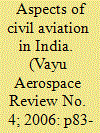

|
|
|
| 2 |
ID:
125370
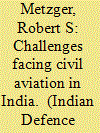

|
|
|
|
|
| Publication |
2013.
|
| Summary/Abstract |
Civil aviation in India may be taken as a study in contrasts. Despite extraordinary growth in traffic, most of India's airlines are in a precarious condition. Despite forecasts that India will add more than a thousand transport aircraft to civil fleets in the two next decades, India has too few airports and today lacks the aviation safety infrastructure required to handle the growth.
|
|
|
|
|
|
|
|
|
|
|
|
|
|
|
|
| 3 |
ID:
171514


|
|
|
|
|
| Summary/Abstract |
In order to explore the decoupling relationship and its influence factors between the growth of China's civil aviation sector and carbon emissions, as well as to forecast future CO2 emissions, the extended log-mean Divisia index model (LMDI), Tapio decoupling model and an emission prediction model were applied in this study. The results show the following. (1) Total carbon emissions fluctuate on an overall upward trend, but the level of oil consumption per revenue tonne-kilometers (RTK) shows a steady downward trend. (2) Among the four main factors, the “transportation amount growth” factor contributed most to CO2 emissions increases; followed by transport structure adjustment effects and alternative fuel effects. The “energy consumption intensity” factor plays a major role in inhibiting CO2 emissions. (3) The decoupling state of civil aviation predominantly stayed in a weak decoupling prior to 1988, expansive coupling and expansive negative decoupling during 1988–2000, and expansive coupling post-2000, which implies that the government should take comprehensive measures to reduce CO2 emissions. (4) Based on eight scenarios, China's civil aviation sector is predicted to be responsible for 0.13 Gt of CO2 emissions by 2020. Between 2020 and 2050, CO2 emissions may increase by a factor 1.6 to 3.9.
|
|
|
|
|
|
|
|
|
|
|
|
|
|
|
|
| 4 |
ID:
104707
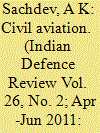

|
|
|
| 5 |
ID:
137886
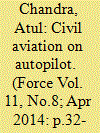

|
|
|
|
|
| Summary/Abstract |
Already one of the world’s largest defence markets, India aspires to grow into the third largest aviation market globally, in the next six years (by 2020). The immense potential offered as a result of this, and indeed the urgency, leads one to wonder as to how did we end up with two major shows this year (DefExpo and India Aviation), that were dead in the water from day one?
|
|
|
|
|
|
|
|
|
|
|
|
|
|
|
|
| 6 |
ID:
131039
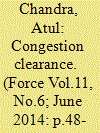

|
|
|
|
|
| Publication |
2014.
|
| Summary/Abstract |
India's growing civil aviation sector now has an increasing number of scheduled, non-scheduled airlines, flying institutes and private-use aircraft that will require a larger number of airports and airfields to enable air connectivity across all corners of the country.
The Airports Authority of India (AAI) had already begun work on 50 low-cost airports, located in remote and interior areas of the country. In addition to this greenfield airports at Navi Mumbai, Goa, Kannur and Kushinagar, AAI has identified six airports for private management under the Public Private Partnership (PPP) route following the successful implementation of PPP models in Delhi, Mumbai, Bengaluru, Hyderabad and Cochin.
All these measure will not only lead to more airports but also increased utilisation of existing airports, thus helping to increase air traffic but at the same time putting additional pressure on airspace management. In another recent move, the government allowed flexi use of airspace by civil and military users on a sharing basis, which will enable the available airspace to be used in a more optimised and effective manner.
|
|
|
|
|
|
|
|
|
|
|
|
|
|
|
|
| 7 |
ID:
109049
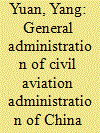

|
|
|
| 8 |
ID:
070643
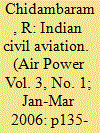

|
|
|
| 9 |
ID:
138801
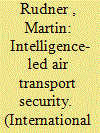

|
|
|
|
|
| Summary/Abstract |
International terrorism has a history of targeting airliners and airports. The deadliest-ever single act of terror against civil aviation was the 1985 bombing by Sikh terrorists of Air India flight 182 from Toronto over the Irish coast, with a loss of 329 passengers and 22 crew members. Since the 1990s, civil aviation has emerged as a principal target for various militant Islamist groups. Certain foreign governments, among them the Islamic Republic of Iran, are known to deploy client terrorist groups, like Hizbullah, for terrorist operations against countries toward which they are hostile. State-sponsored terrorism was responsible for the 1988 bombing of Pan Am flight 103 over Lockerbie, Scotland, with the loss of 259 lives, for which a Libyan intelligence officer was subsequently convicted but subsequently released before completing his jail term.
|
|
|
|
|
|
|
|
|
|
|
|
|
|
|
|
| 10 |
ID:
131192
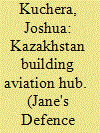

|
|
|
|
|
| Publication |
2014.
|
| Summary/Abstract |
Kazakhstan is constructing an aviation service centre that will serve as the hub for a variety of aviation joint ventures it plans to establish with foreign firms.
|
|
|
|
|
|
|
|
|
|
|
|
|
|
|
|
| 11 |
ID:
131040
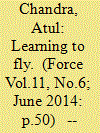

|
|
|
|
|
| Publication |
2014.
|
| Summary/Abstract |
Just over a year ago in July 2013, the High Level Committee on Manufacturing (HLCM) headed by the then Prime Minister Manmohan Singh gave the go-ahead for the manufacture of a civil aircraft in India. The decision was taken with the view that this was "a strategic sector where there was a need to have a presence in the long term, particularly in view of the rapid growth of the aviation sector." As a result "the HLCM took a major strategic decision for the development of a civilian aircraft, of a 70-100 seater range to begin with, in India."
|
|
|
|
|
|
|
|
|
|
|
|
|
|
|
|
| 12 |
ID:
162680
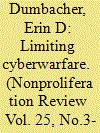

|
|
|
|
|
| Summary/Abstract |
An arms race in cyberspace is underway. US and Western government efforts to control this process have largely been limited to deterrence and norm development. This article examines an alternative policy option: arms control. To gauge whether arms-control models offer useful lessons for addressing cyber capabilities, this article compiles a new dataset of predominantly twentieth-century arms-control agreements. It also evaluates two case studies of negotiated agreements that regulate dual-use technologies, the 1928 Geneva Protocol prohibiting chemical- and biological-weapon use and the 1944 Chicago Convention on International Civil Aviation. The analysis underscores the limits of norm development for emerging technologies with both civilian and military applications. It finds lessons for developing verifiable, international cooperation mechanisms for cyberwarfare in the regulatory model of international aviation. Conventionally, arms-control agreements take advantage of transparent tests or estimates of arms. To restrict cyberwarfare activities, experts and policy makers must adapt arms-control models to a difficult-to-measure technology at an advanced stage of development and use. Further investigation of international regulatory schemes for dual-use technology of similar diffusion and development to the internet, such as international civil aviation, is needed.
|
|
|
|
|
|
|
|
|
|
|
|
|
|
|
|
| 13 |
ID:
137888
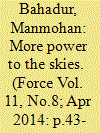

|
|
|
|
|
| Summary/Abstract |
Air power is not just a country’s air force or the air arms of all its armed forces put together. Air power of a nation, as defined in the Basic Doctrine of the Indian Air Force (IAF) is “the total ability of a nation to assert its will through the medium of air. It includes both civil and military aviation, existing and potential.” An understanding and assimilation of this basic fact, and planning and putting in place a system to harness the extraordinary airlift capability of civil aviation, is germane to acquiring true air mobility and lift in times of need – both in peace and in war.
|
|
|
|
|
|
|
|
|
|
|
|
|
|
|
|
| 14 |
ID:
132816
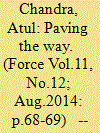

|
|
|
|
|
| Publication |
2014.
|
| Summary/Abstract |
In what can only be termed as a welcome move, aerial connectivity for India's hinterland is receiving a push with the new government. In its first budget, the government announced: "Plans to build 200 low-cost airports in the next 20 years to connect Tier-II and Tier-III cities." Adding that it "also plans to construct 15 additional airports under the Greenfield Airport Policy by identifying the most suitable low cost viable model. Budgetary support of Rs 50 crore has been provided to Directorate General of Civil Aviation (DGCA) to pursue their plan scheme.
|
|
|
|
|
|
|
|
|
|
|
|
|
|
|
|
| 15 |
ID:
133500
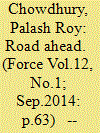

|
|
|
|
|
| Publication |
2014.
|
| Summary/Abstract |
It is well established that the Indian aviation sector has shown robust growth over the last decade and continues to offer significant potential for further growth in the coming years.
Aviation is a key infrastructure sector that is instrumental in the economy's development. It increases the pace of urbanisation and technology enhancement that leads to employment opportunities.
India continues to add more than 10 million people on an average to the workforce every year. Millions of people are migrating to urban centres in one of the largest urban exodus in human history. These megatrends, coupled with infrastructure investments and the advent of low cost airlines, are some of the key drivers of growth in travel and aviation sectors.
|
|
|
|
|
|
|
|
|
|
|
|
|
|
|
|
| 16 |
ID:
119328
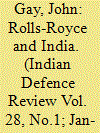

|
|
|
| 17 |
ID:
133499
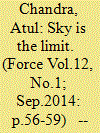

|
|
|
|
|
| Publication |
2014.
|
| Summary/Abstract |
The Indian civil aviation sector is slowly coming out of the gloom that enveloped the sector over the last few years. The new government, while seized of the issues that beset the sector as a whole, faces an unenviable task in getting the civil aviation sector back on the road to good health.
|
|
|
|
|
|
|
|
|
|
|
|
|
|
|
|
| 18 |
ID:
150836
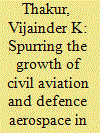

|
|
|
| 19 |
ID:
126710


|
|
|
|
|
| Publication |
2013.
|
| Summary/Abstract |
For the best part of three decades, from 1946 until 1977, civil aviation played a central role in Dutch-American diplomatic relations, consistently causing major friction at the highest levels of both the government and the business sector on both sides of the Atlantic. Yet up till now this remarkable episode in the relations between two close transatlantic allies has remained under-researched and neglected by traditional diplomatic historians unable to grasp its full significance. The dispute centered on the ostensibly anodyne wish of the Dutch national airline, KLM, to expand its access to airports in the United States. Yet the "landing rights question" exposed more than ever the uneven power relations, clashing national interests, and antagonistic perceptions that lay behind the otherwise friendly relations between Washington and The Hague. The article examines the causes and consequences of these tensions through four intense periods of negotiations in the 1940s, 1950s, 1960s, and 1970s, each case involving a set of actors, interests, and strategies. On the U.S. side, the divergence between diplomatic and commercial interests lay at the heart of a hard-nosed civil aviation policy that was not prepared to give the Dutch what they wanted. Meanwhile for the Dutch, KLM represented the epitome of national pride and pioneering enterprise, and U.S. intransigence on the landing rights issue was regarded as hypocritical and a direct threat to the continuing vitality of the airline itself. Looking to overcome this asymmetric deficit, the Dutch employed various strategies-public diplomacy, the contacts of elite networks, the "rights" of a close ally-to secure results. Coming from the perspective of "New Diplomatic History," the article maintains that traditional state-centered historiography tends to miss the deeper terrain on which bilateral and multilateral relations among the western allies were conducted. As a result, it provides a behind-the-scenes view of alliance politics from a unique angle during the Cold War.
|
|
|
|
|
|
|
|
|
|
|
|
|
|
|
|
| 20 |
ID:
132257
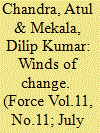

|
|
|
|
|
| Publication |
2014.
|
| Summary/Abstract |
Ensuring that delayed crucial aviation projects are delivered fast should be the new government's priority
Hope is riding high on the new Narendra Modi government. Little over a month after assuming the high office, India's Prime Minister has managed to boost the confidence of the Indian military forces. While symbolic gestures like spending a day aboard INS Vikramaditya helped to bring in motivation to the Indian Navy, which was plagued by series of accidents in the last few months; it is his policy decisions like opening up the defence industry to the private sector that has attracted foreign investors' confidence.
|
|
|
|
|
|
|
|
|
|
|
|
|
|
|
|
|
|
|
|
|